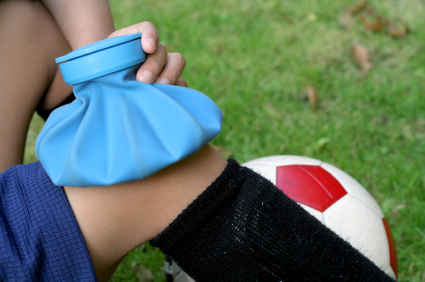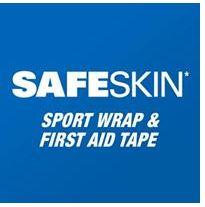The first four steps* of first aid for injuries such as ankle sprains are known by the acronym "RICE," which stands for rest, ice, compression, and elevation:
Rest. When your child is injured, small blood vessels at the injury site rupture and cause tissue bleeding, which, in turn, causes bruising and swelling. Because the swelling can produce more damage than the initial injury, it is important for your child to stop exercising immediately because moving forces more blood into the damaged area and cause further injury to the tissue. Not only is rest important in the period immediately after your child is injured, but adequate rest is necessary before your child returns to sports. Returning too soon from an injury can cause further damage and result in a chronic, long-term condition, such as chronic ankle instability, even permanent disability. (Note: not all kids swell; even if there is no visible swelling or bruising, pain is an indicator of injury and means that rest is needed)

Ice. Apply ice continuously for the first 15 minutes to decrease swelling and pain. Ice can be re-applied for 15 minutes after approximately 30 minutes, or until the superficial skin and soft tissue is of equal temperature to the uninjured side. Icing too early could cause the superficial skin to freeze, result in nerve damage, or skin irritation or blistering. Always place a barrier, such as a paper towel, washcloth, or ice bag, between the ice and skin. Because ice is so important, make sure that someone brings ice to every practice and game. Better yet, to be on the safe side, bring your own! Remember: ice is the best anti-inflammatory around; if pain returns when your child returns to play, kids should use it liberally.
Compression. To prevent swelling, wrap the injured area with an elastic ("ace") bandage or compression sleeve to assist in re-absorption of cellular waste and bleeding. A wrap should always be applied distally to proximally (e.g. ankle-toes to shin, wrist-fingers to forearm). The tightest part of the wrap should be at the distal end and the lightest part should be at the proximal end to assist in the fluid being pushed toward the midline of the body for quicker absorption. Wrapping the wrong way could cause a tourniquet-like effect (e.g. cut off circulation, such as turning the fingers or toes blue) and cause further pain and damage.
Elevation. For both upper and lower limb injuries, it is equally important to keep the arm elevated in either a position above the head while lying down or in a sling if one is indicated. Both upper and lower limbs swell easily due to the gravity dependent position that they are in while walking, sitting or standing.
Return to play
In addition to rest, ice, elevation, and compression, restoring range of motion (ROM) is an important part of the recovery process when the swelling and pain begins to subside. Active ROM of an injured joint assists in introducing new blood flow to the injury site to "flush" out any residual cellular waste and joint edema present. Motion also assists in decreasing scar tissue and adhesion formation and stimulates the nervous system to begin activating the muscles that control strength, balance, and proprioception (position-movement sensation or body awareness) when return to play occurs. An athlete experiencing pain or swelling upon return to play or during rehab prior to play should seek the advice of a physician for further evaluation and/or diagnostic testing.
Return to play should ultimately be dictated by:
- pain-free, full range of motion;
- equal strength compared to the uninjured side;
- elimination of bruising and swelling;
- equal balance compared to the uninjured side (if it is a lower body injury); and
- no residual gait deficits.









